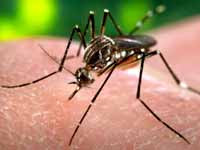AH1N1 or swine flu may hospitalize 1.8 million patients in the United States this year, filling intensive care units to capacity and causing “severe disruptions” during a fall resurgence, scientific advisers to the White House warned.
The flu may also infect as much as half of the population and kill 30,000 to 90,000 people, double the deaths caused by the typical seasonal flu, according to the planning scenario issued by the President’s Council of Advisers on Science and Technology. Intensive care units in hospitals, some of which use 80 percent of their space in normal operation, may need every bed for flu cases, the report said.
The virus has sickened more than 1 million people in the United States, and infections may increase this month as pupils return to school, according to the Centers for Disease Control and Prevention. If swine flu patients fill too many beds, hospitals may be forced to put off elective surgeries such as heart bypass or hernia operations, said James Bentley with the American Hospital Association.
“If you have 1.8 million hospital admissions across six months, that’s a whole lot different than if you have it across six weeks,” said Bentley, a senior vice president of the Washington-based association, which represents 5,000 hospitals.
President Barack Obama was urged by his scientific advisory council to speed vaccine production as the best way to ease the burden on the health care system. Initial doses should be accelerated to mid-September to provide shots for as many as 40 million people, the panel said in a report. Members also recommended Obama name a senior member of the White House staff, preferably the homeland security adviser, to take responsibility for decision-making on the pandemic.
“This isn’t the flu that we’re used to,” said Kathleen Sebelius, health and human services secretary. “The 2009 AH1N1 virus will cause a more serious threat this fall. We won’t know until we’re in the middle of the flu season how serious the threat is, but because it’s a new strain, it’s likely to infect more people than usual.”
Data from clinical trials to assess the safety and effectiveness of swine flu vaccines will start to become available in mid-September, health officials reported on August 21. Full results from the two-dose trials won’t be available until mid-October.
“We are making every preparation effort assuming a safe and effective vaccine will be available in mid-October,” Sebelius said at the CDC’s Atlanta offices.
H1N1 has already reached more than 170 countries and territories in the four months since being identified, the Geneva-based World Health Organization said. Swine flu causes similar symptoms as seasonal strains. It has so far resulted in worse than normal flu seasons, with increased hospitalizations and cases of severe illness, the WHO said in an August 12 release.
New Zealand and Australia, in the midst of their normal flu seasons, have reported intensive care units taxed to capacity by swine flu patients. The experience provides clues to what the United States, Europe and Japan may see when the AH1N1 virus returns.
The president’s advisory council describes as a “plausible scenario,” that 30 percent to 50 percent of the US population will be infected in the fall and winter. As many as 300,000 patients may be treated in hospital intensive care units, filling 50 percent to 100 percent of the available beds, and 30,000 to 90,000 people may die, the group’s report said.
“This is a planning scenario, not a prediction,” according to the report. “But the scenario illustrates that an AH1N1 resurgence could cause serious disruption of social and medical capacities in our country in the coming months.”
Peter Gross, chief medical officer at Hackensack University Medical Center in New Jersey, said if the group’s scenario comes true, “I think every hospital in America is going to be in a crunch. We’ll be hard pressed to deal with those predictions,” he said.
The estimates seem “overblown,” Gross said, given that swine-flu outbreaks in 1968 and 1957 failed to cause as many deaths, even with medical technology and disease surveillance less advanced than today.
“Influenza, you can make all the predictions you want, but it’s more difficult than predicting the weather,” Gross said in a telephone interview, after the advisory report was made public. “If influenza was a stock, I wouldn’t touch it.” (Bloomberg)
Situation In Malaysia
Death toll due to influenza reaches 70 now.
There is a possibility that over 140,000 Malaysians have been infected with the recent outbreak of Influenza A(H1N1), according to Health Minister Datuk Seri Liow Tiong Lai, he added that this possible statistic was based on the number of confirmed cases reported by the ministry since May.
Situation in Japan
The new A/H1N1 strain of influenza, which has killed three Japanese in the past week, has reached the epidemic stage in the country, the Health, Labor and Welfare Ministry announced Friday, with 110,000 Japanese estimated to have been infected.
The number of influenza patients reported by about 5,000 designated medical institutions across the country during the week of Aug. 10 to last Sunday stood at 7,750, or 1.69 per facility, topping the 1.00 benchmark that is deemed the beginning of an epidemic, the National Institute of Infectious Diseases said in a preliminary report released the same day.
Based on reports from the designated facilities, the institute estimated 110,000 people have been infected with the new flu.
Health, Labor and Welfare Minister Yoichi Masuzoe had issued a de facto "epidemic declaration" on Wednesday as the figure for the previous week of Aug. 3-9 was 0.99. About 60,000 people were estimated to have been infected during that week.
The number of patients, however, has increased by 70 percent since then.
Although the figures include seasonal influenza patients, the ministry believes most of them have been infected with the new H1N1 strain, Masuzoe said.
Patients under 20 thus accounted for about 80 percent of hospitalized new-flu patients in that period. Ninety-three hospitalized patients, or about 40 percent, had chronic and other illnesses.
People suffering from chronic diseases, pregnant women, babies and young children are thought to be at high risk of developing serious health problems, such as pneumonia and other diseases, after becoming infected with the new influenza virus. The ministry plans to hold briefings for groups of patients and parents of young children next month to provide information to people most susceptible to serious illness.
The ministry also intends to survey medical institutions on such matters as the number of artificial respirators and intensive care units available for critically ill patients.
Outbreaks of influenza rarely occur in summer because flu activity normally wanes due to the hotter weather and higher humidity. However, the new strain of influenza appears to be raging out of control even in summer because most people do not have immunity to the virus yet.
The new A/H1N1 strain of influenza, which has killed three Japanese in the past week, has reached the epidemic stage in the country, the Health, Labor and Welfare Ministry announced Friday, with 110,000 Japanese estimated to have been infected.
The number of influenza patients reported by about 5,000 designated medical institutions across the country during the week of Aug. 10 to last Sunday stood at 7,750, or 1.69 per facility, topping the 1.00 benchmark that is deemed the beginning of an epidemic, the National Institute of Infectious Diseases said in a preliminary report released the same day.
Based on reports from the designated facilities, the institute estimated 110,000 people have been infected with the new flu.
Health, Labor and Welfare Minister Yoichi Masuzoe had issued a de facto "epidemic declaration" on Wednesday as the figure for the previous week of Aug. 3-9 was 0.99. About 60,000 people were estimated to have been infected during that week.
The number of patients, however, has increased by 70 percent since then.
Although the figures include seasonal influenza patients, the ministry believes most of them have been infected with the new H1N1 strain, Masuzoe said.
Patients under 20 thus accounted for about 80 percent of hospitalized new-flu patients in that period. Ninety-three hospitalized patients, or about 40 percent, had chronic and other illnesses.
People suffering from chronic diseases, pregnant women, babies and young children are thought to be at high risk of developing serious health problems, such as pneumonia and other diseases, after becoming infected with the new influenza virus. The ministry plans to hold briefings for groups of patients and parents of young children next month to provide information to people most susceptible to serious illness.
The ministry also intends to survey medical institutions on such matters as the number of artificial respirators and intensive care units available for critically ill patients.
Outbreaks of influenza rarely occur in summer because flu activity normally wanes due to the hotter weather and higher humidity. However, the new strain of influenza appears to be raging out of control even in summer because most people do not have immunity to the virus yet.
Earth becoming a disease hot spot : The warming earth is making us sick. Rising temperatures, frequent floods and prolonged droughts are ideal conditions for infectious diseases to spread. "Global warming is fuelling epidemics in areas which are unprepared. We're seeing the emergence of new diseases around the world. Old diseases are also coming back with a vengeance," Climate change has dramatically changing infection trends.
DENGUE DEATH CASES INCREASES BY 65% IN 2010
SAVE THE WORLD - STOP GLOBAL WARMING

Either You're With Me or You're Against Me in Stopping Global Warming!
Global Warming Articles
Let's Go Green & Save The World : Mentor Gemilang
The Truth Hurts - Truth is such a rare thing, it is delighted to tell it.

You can fool some of the people all of the time, and all of the people some of the time, but you can not fool all of the people all of the time.
Most truths are so naked that people feel sorry for them and cover them up, at least a little bit.
Truth always rests with the minority, and the minority is always stronger than the majority, because the minority is generally formed by those who really have an opinion, while the strength of a majority is illusory, formed by the gangs who have no opinion
Let's Go Green - Mentor Gemilang 1 - Visitors from 90 Countries
LATEST NEWS
Are u protected against Influenza A(H1N1)?
Repentance (At Taubah)
We can never be perfect since even prophets have at times made mistakes. Repentance means to abandon one's rebelliousness and arrogance before God and to stop deliberately disregarding His commandments without feeling any shame. Repentance also means to humbly hope for the mercy of God and to fear His judgment while doing the best one can to fulfill divine wishes within the limits of one's human weaknesses.


